I found this in an old e-mail folder- its already 4 years old, but the trends are clear.
20 Years of Kirkby Primary Care: The Changing Numbers of Family Doctors
A nation that keeps one eye on the past is wise. A nation that keeps two eyes on the past is blind.
Introduction
The future of primary care is once again at a cross roads, this appears to happen every 10 years or so. Changes such as locality purchasing, PCT, PBC, GPCC, CCG and now CCCs appear and mutate the very DNA of primary care. It’s often said that General Practice remains a constant and that alterations in the delicate ecosystem will “destabilise” services. This belief, whilst comforting is not actually true. Primary Healthcare is a complex adaptive system, constantly changing and evolving to meet the demands of the system and the population it services.
This paper draws on simple demographic changes in the nature of practices and practitioners and attempts to pull out some threads for development which others may choose to fashion into a safety net or hangmans noose, depending on their preference.
Although as GPs we pride ourselves on continuity of care and accessibility the experience of patients based on their own experience does not always agree with perceived wisdom.
I recently came across some documentation from 1988, the year I qualified as a Doctor. This outlined some simple demographics for the GP population of Kirkby. The same information is available to day and perhaps the comparisons of the changes offer some insight into the changes we may expect or even create in the next twenty years, not for the patients but for ourselves as individual practitioners, the way we work and the people we are.
As with all predictions there is a health warning. The more precise the prediction the less accurate it will become. So predicting the future demographic of primary care down to individual GP numbers is nonsensical, but broad strokes of strategic direction will for the most part be made real to greater or lesser extent.
The Population
Kirkby was developed in the 1950s as an overspill town for Liverpool, it reached its population maximum in the 1970s, 10,000 short of its predicted target and since then there has been a decline in the population numbers with a stabilisation and slight growth since the 1990s.
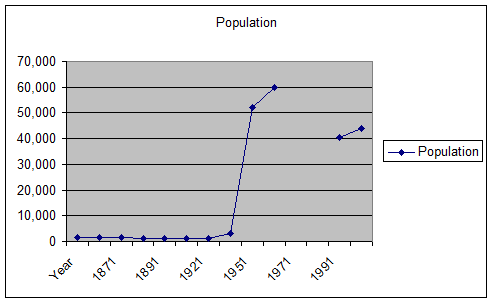
No data available for 1981 1991.
The ageing population demographic applies to Kirkby equally as to the rest of the county, however health needs are significant. NHS Knowsley Annual Report has full details.
The 1988 Position.
The St Helens and Knowsley Family Practitioner Committee document “A strategic statement for the development of Family Practitioner Services” provides basis demographics for the population of General Practitioners.
The document also outlined a number of challenges such as computerisation which would need to be addressed for primary care to develop.
The data is not clear as to WTE figures simply stating GP numbers age and Gender. Aside from trainees there was no mention of salaried or long term locum posts.
This data would appear to be based on performers’ list details alone and so the 2011 data can be sampled in a similar blunt way.
Comparisons
Numbers of GPs.
The table below illustrates a stark truth- the overall numbers of GPs have changed little since 1988. However the expansion of the primary health care teams has been massive.
|
|
Drs |
Trainees |
|
1988 |
28 |
3 |
|
2011 |
33 |
3 |
In 2011 all practices have some nurse support, the community teams have increased in size with new posts such as Community Matrons, Practice based pharmacists and Independent Nurse prescribes completely unpredicted by 1988 data.
The Options service has also been excluded from the data since the nature of that service is a pan Knowsley one and the model of employment means that actual WTE data vs. Individual Names not available.
Who are the Doctors?
In 1988 25% of the Medical body was female, this has increased to 33% by 2011, however this is still short of the current 42% national figure and the 50% Male: Female figure leaving Medical School. Given the increased uptake of part time work by GPs who are also main carers for children it should be expected that more of our population of Medics will be female in the next decade.
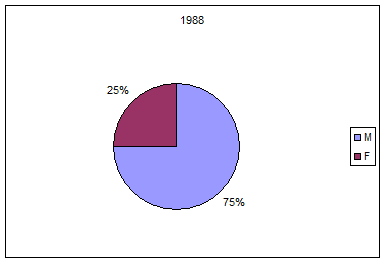
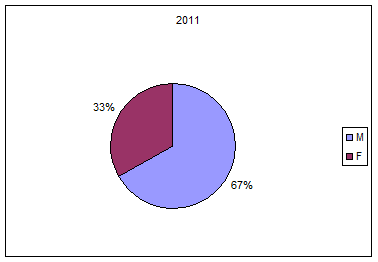
Have we aged well?
It would appear that with the notable exception of Dr Ford we have indeed aged well as a population. Although Dr Ford has since retired from practice the figures were generated at a time when Colin was still active.
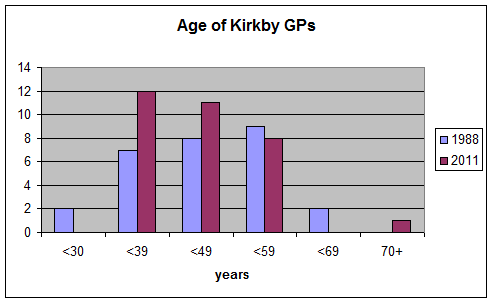
Over the next 20 years we can expect 20% of or GP population to retire and be replaced and the figures do not appear to be a cause for concern regarding sudden departures. However the pension changes and external factors may simultaneously force retirement n some and prolonged working life on others. A solution may arise in practitioners “winding down” and becoming part time, at the same time as younger female medics are seeking part time employment.
What kind of Practices do we work in?
This data is the most interesting to note, given that the overall numbers appear to have changed little, has the nature of practice also changed little?
The answer would appear to be a significant shift, possibly to the extent of polarisation.
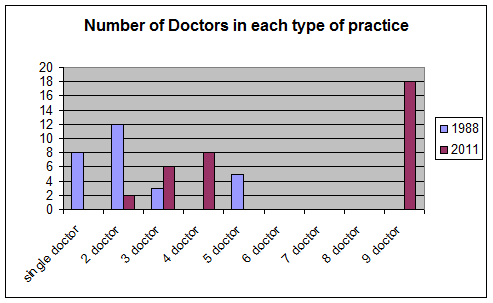
In 1988 the largest practice in Kirkby had 5 GPs whilst there were 8 who appear from the data to have been in single handed practice, a total of 16 separate medical facilities.
By 2011 there are no longer any lone practicing GPs in Kirkby with 16 GPs working in 5 2-4 doctor practices and 18 working in a brace of 9 doctor practices. This gives a total of seven medical practices.
This wholesale centralisation has multiple drivers, not least concerns over isolated practitioners, economies of scale and estates infrastructure development which have all conspired to develop the reduction in practice numbers and increase in practitioner team size which is clearly evident.
Where now?
As mentioned these are interesting times for the NHS and Kirkby and the vie of a world twenty years behind us does not predict the future, however it does show where we were, where we are and hence where we might go.
The NHS faces the Nicholson Challenge- a reduction of activity and expense to the tune of £20 Billion is required by the NHS. The coalition government strategy is forcing GPs to embrace a broader role in the commissioning of services, with subsequent impact on day to day care activity and for the Kirkby GPs questions remain about the viability of a commissioning unit with 50, 000 patients and 33 GPs.
The changes in the nature of practices observed might suggest development of a co-ordinated approach, hub and spoke services, a collaborative environment. The reality is that we are not established in such a way at this time.
The new town centre development offers a potential catalyst, with the co-location of walk in services, practices and the facilities associated with St Chads and the Kirkby health suite there is a golden opportunity to develop a different healthcare system for the population. One which maximises the potential of collaboration between practices, uses the demographics of our General Practice environment to the fullest and as a result provides a new deal for the Kirkby population.
As one local GP suggested we should “Consider ourselves as mid size company with 8 practices [inc options], £75m turnover and lots of employees and 50k customers.”
Dr Chris Mimnagh June 2011
